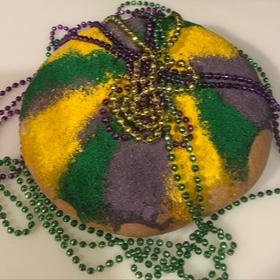Ingredients
Dough:
1 cup starter
1/2 cup whole milk
1/4 cup sugar
1 teaspoon salt
2 eggs
6 tablespoons (3 oz.) unsalted butter, softened, cut into 12 pieces
1 1/2 cups bread flour
1 1/2 cups AP flour
Filling:
2/3 cup packed light brown sugar
1 tablespoon ground cinnamon
1 tablespoon flour
4 tablespoons (2 oz.) unsalted butter, softened
Glaze:
1 cup powdered sugar
2 tablespoons milk
1/2 teaspoon vanilla
Dark green, purple, and yellow or gold sanding sugar
Miniature plastic baby, if desired
Description
Festive dessert associated with Epiphany, that is especially synonymous with New Orleans and Mardi Gras. Eaten between the Twelfth Night (January 6th) and Ash Wednesday (the day after Mardi Gras).
Directions
Heat milk, sugar, and salt in a small saucepan over medium heat until sugar is dissolved. Let cool.
Put your starter in your bowl. Use your paddle attachment. With mixer on low, pour in the milk and mix until incorporated.
Add eggs one at a time and continue mixing.
Switch to the dough hook attachment. Add the bread flour a little at a time, scraping the bowl as needed. Add some of the AP flour a little at a time until incorporated.
Add the softened butter, a piece at a time, kneading until each piece of butter is absorbed.
Knead for eight minutes on low and incorporate the remaining flour a little at a time.
The dough should completely clear the sides of the bowl. If it is too sticky, add more flour 1 tablespoon at a time, mixing in thoroughly before determining if more flour is needed.
Turn the dough out onto a lightly floured surface and knead a few times by hand to be sure it’s smooth and elastic. Form the dough into a ball. Place dough into a greased container. Turn once so greased surface is on top. Cover container with plastic wrap or a lid and refrigerate for 2 hours.
While the dough is chilling, make cinnamon filling.
In small bowl, combine the brown sugar, ground cinnamon, and flour. Combine butter with cinnamon mixture and mix well.
Roll the chilled dough into a large rectangle.
Spread the filling over the dough. Roll up from the long side, using a bench scraper to help you lift the dough if necessary. Pinch the seam into the roll.
Transfer the log to a parchment or silicone lined baking sheet seam side down. Shape into a circle, oval, or loose spiral. With a circle or oval, squash and pinch the ends together the best you can.
Spritz the dough with water and let it rise until doubled, about 1 1/2-2 hours.
While the dough is rising, preheat the oven to 350°.
Bake the cake until it is golden brown, 20–35 minutes, or until a thermometer inserted into the center registers between 190 and 200 F.
Remove from oven and let cool 10 minutes on baking sheet and then place it on a cooling rack to cool before icing.
To hide the baby in the cake, if desired, make a small slit in the bottom of the cake and put the miniature plastic baby in after the cake has cooled.
In a small bowl, mix powdered sugar, milk and vanilla until smooth (add additional milk if mixture is too thick).
Pour icing over top of the cake. Immediately sprinkle on colored sugar, alternating between the three colors. Let dry, very gently brush away loose sugar, and move to a serving platter or cutting board.
With dry yeast:
In place of starter, mix 1 cup of flour, 1/2-1 cup milk (it should be a pancake batter consistency), and 2 1/4 tsp. dry yeast (1 packet). If it doesn’t mix smoothly, add a little more milk until it does. Let sit until bubbly, then follow the recipe as written.
Notes
Sanding Sugar Makes more than enough for several cakes and is good for a very long time.
Nutrition
Fat: 2
Calories: 350
Saturated Fat: 7 g
Trans Fat: 0 g
Sodium: 220 mg
Fiber: 1 g
Sugar: 27 g
Carbohydrate: 56 g
Cholesterol: 60 mg
Serving Size: 1 Serving
Protein: 6 g
